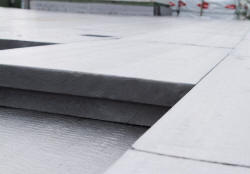| |
| “When I first
entered what was then a rather limited thermal insulation industry, over
twenty five years ago - selling STYROFOAM extruded polystyrene insulation to
architects and end users of all types - I was amused by the fact that as a
nation we were insulating many agricultural buildings far better than any
new properties built for human occupation. |
 |
|
Don’t get me wrong, I didn’t begrudge the
chickens and pigs a warm bed for the night, but they, or their chicks and
piglets, didn’t have to worry about the cost of turning up the thermostat to
cope with cold snaps: after all, at Dow we were busy helping to wrap their
sheds with cosy SYTROFOAM! |
|
Subsidies no doubt helped, but along with animal welfare, energy costs were
of primary importance and the main driver for the farmer. Let’s just say,
common economic sense prevailed! |
| Over
the years, the construction industry began to make progress and the use of
thermal insulation began to take shape. However, until more recently, its
use was pretty limited. Back in the 80s, pioneering property developers
installed 50mm of fibre in the loft and 25mm of board foam into cavity
walls. It was good news, and a step in the right direction (considering
there was no legislation driving it – only a document asking them to make
‘reasonable provision’ for the conservation of fuel!). However, it’s worth
pointing out that at the same time the piglets were snuggled up with 80mm
thickness of insulation! |
| As with the farmer
back then, the burden of energy costs are catching up with us all, and fast
- at home, in the office we work in or at our manufacturing facilities. Here
in the UK, we really shouldn’t be facing the fact that more people are being
pushed into fuel poverty, which of course has its own impact on health and
well-being. In short, unless things change, energy costs threaten to become
the enemy of financial freedom for a significant section of the population
and a competitive burden on the UK as it competes in a global economy. |
 |
| But
it’s far from all doom and gloom. Government departments such as the
Department for Energy and Climate Change (DECC) are thankfully taking the
issue very seriously. I am pleased to say that over the recent decade or so
energy efficiency has become an integral part of any new building for human
occupation. |
| There
are of course more steps to take before we can consider our work done, but
we can thank pioneers such as the Association for the Conservation of
Energy, whose bold efforts have brought about changes in legislation and
helped to establish what is required for continued future improvement.
|
|
Farmers saw the benefit of improved energy efficiency because they were
paying the energy bill and wanted their animals to thrive. But, think about
this - building designers, developers or contractors rarely pay the energy
bills. It’s a shame, but it’s fact that it takes progressive legislation to
increase energy efficiency and make a change that will, at some time in the
not too distant future, mean that the owner or occupier of a newly built
property will not be burdened with escalating energy costs. |
|
Buildings last a long time and many of our families, friends and neighbours
are still living or working in old, poorly insulated or even completely
un-insulated buildings. However, the framework to make real change is here
and now. The noise is louder than ever before, and not just within
government and industry: people around the UK are finally talking about
energy efficiency of the buildings they occupy. |
| This means that an
opportunity for British industry is unfolding, not just in the construction
market, but the manufacturing industry, the chemical industry, the services
industry, the energy sector, and beyond. The prospects for growth in my
specific industry – thermal insulation - are better than ever. |
 |
| So what role can
innovation play? As a manufacturer of thermal insulation products we’ve been
developing ever thicker products that deliver more insulation ‘power’.
|
| We are
seeing the tide turn. In the past, thermal insulation had to fit with
building methods, but now for the first time, building methods themselves
are changing because of the demand for greater insulation thicknesses.
|
| We’ve
also made strides in the processes we use to manufacture insulation
materials. We at Dow take carbon dioxide from industry and use it a blowing
agent to produce our foams, bringing major environmental improvements. |
| But
let’s face it, apart from overcoming some mechanically challenging
production limitations and technical hurdles, that’s really as far as we’ve
got: the biggest opportunity is yet to come if we are willing to embrace it. |
| If we
want thermal insulation within the construction industry to up its game and
create the next generation of insulation products and solutions, then we in
industry must play our part and rise to the challenge. Those who dare will
win – those who invest in new thinking, in research and development and
ultimately in new production methods are the future. |
| My
dream is for the next generation of insulation to emerge as being painted
on, wrapped around, unfolded, or stretched into place. And to me that is the
day the thermal insulation industry will have truly entered the 21st century
and come of age. |
| So the
opportunity to really innovate is finally with us. If we in industry embrace
it, we become creators, leaders, exporters, winners in a whole new world of
energy efficient solutions. |
| The
new home, office, school or hospital of this decade – with true commitment
to building regulations and progressive legislation - will need walls
consisting of at least 200mm thick thermal insulation. And all around us,
old buildings need to be re-furbished to that standard too. |
|
However, in order to be practical, that 200mm thick of thermal insulation
will actually need to be 50mm or far less, yet offer the same thermal
performance. It’s now time for a step change in science, in attitudes, in
investment and joint government-industry commitment to make the difference.
|
| Thanks
to DECC and initiatives such as the Green Deal and ECO, we in industry have
the platform: so let’s not waste the opportunity.” |
|
For more information on Dow
Building Solutions see
www.roofinfo.co.uk/dow |
| |